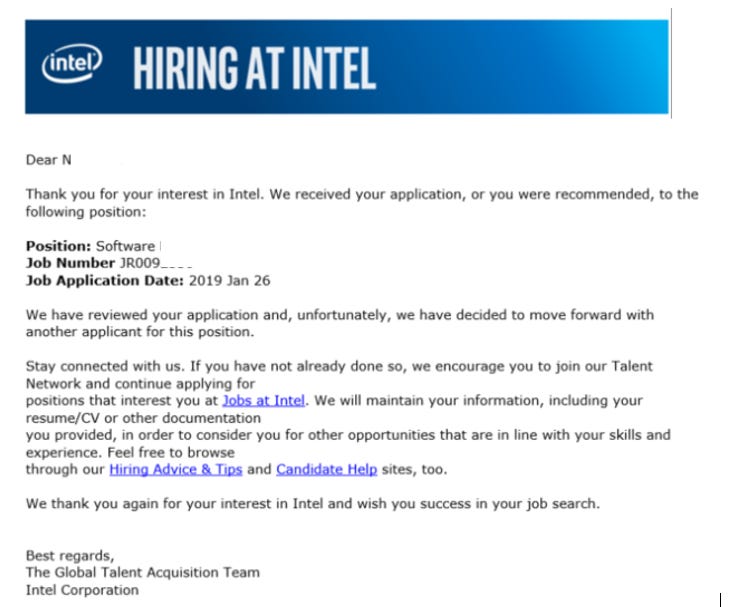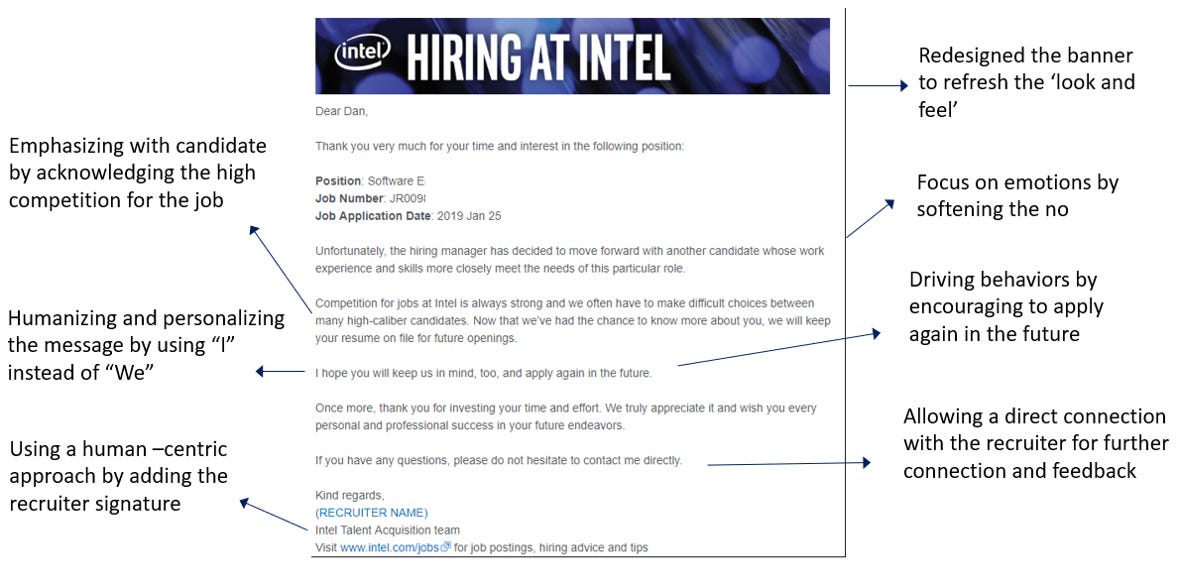Most rejection letters suck. Time to fix it.
For every hire, there are 10-50+ candidates who get rejected. Intel turned this painful moment into their biggest recruitment advantage.
This week's newsletter comes from Shira Ben Cohen. Shira has a unique story: she started as a recruiter, applied product techniques to her work, and fell so in love with the approach that she became a UX researcher and design strategist with over 10 years of experience at companies like Intel and Citi. In this edition, she shares how she reinvented Intel's candidate rejection process using Product Thinking—packed with techniques you can apply today.
💔 The harsh truth about saying no
Here's an uncomfortable fact: in talent acquisition, we tell people "no" way more than we tell them "yes."
Think about it. For every hire, there are 10, 20, sometimes 50+ candidates who don't get the job. That's a lot of rejection conversations. And here's the kicker: most companies spend months perfecting their careers page, optimizing application flows, and training interviewers—but when it comes to rejection? Generic ATS templates and radio silence.
We've gotten pretty good at improving application experiences, interview processes, and onboarding flows. But the most painful part of the hiring journey? Rejection. We've barely touched it.
Candidates aren't resume data points—they're real people with dreams, emotions, and expectations shaped by every consumer experience they have. They expect the same level of thoughtfulness from your rejection that they get from their Uber ride or Amazon purchase. When we reject them poorly, we're not just losing that candidate. We're potentially losing their network, their future applications, and our reputation.
At Intel, our annual candidate survey made this crystal clear: candidate experience was great until the rejection point. Then it crashed hard. Candidates who loved us through interviews suddenly rated us poorly after getting a two-line rejection email.
Time to fix this.
🕵️ Going undercover: the rejection research project
I went full detective mode. Here's what I did:
Data deep-dive: Our candidate survey showed experience quality dropped dramatically at rejection—the red flag was impossible to ignore.
Competitive intel: I reached out to my network at top companies, asking: "How do you reject candidates? When? What tools? Who owns it?" Surprisingly, most hadn't really thought about it strategically.
Real talk with real people: I interviewed friends who were job hunting, captured their feelings on video, and collected rejection emails they'd received. The raw emotion was eye-opening.
The insights hit hard. Candidates felt invisible, confused about why they were rejected, and frustrated by generic, impersonal messages that felt like they came from a robot.
🎯 Three principles that changed everything
After analyzing all this data, I extracted three guiding principles that became our north star:
1. Human-centric approach
As recruiting becomes more automated, human connection becomes more valuable, not less.
2. Focus on experience
People want to feel seen and heard. They need to know where they stand and what to expect.
3. Emotions drive behavior
Want candidates to refer friends? Apply again? You need to build relationships—and that means thinking about emotions in your business strategy.
🛠️ From insights to action: the design session
I didn't design the solution alone. I brought together a cross-functional team for a full-day design session focused on:
Building empathy for our candidates
Presenting research findings clearly
Mapping the ideal rejection journey
Creating actionable next steps
The team included recruiters, hiring managers, and communications specialists—everyone who touches the candidate experience.
📝 The transformation: five concrete changes
Here's what we implemented:
1. The "Investment Rule"
Framework for recruiters: the deeper a candidate progresses, the more personalized our rejection communication should be. Phone screen rejection? Brief but kind email. Final round rejection? Personal call or detailed message. We created clear guidelines for each stage of the process.
2. Rewrote "Thanks for applying" notifications
Made them warmer, more human, and embedded with our guiding principles—focusing on making candidates feel valued from the very first touchpoint.
3. Redesigned all ATS rejection messages
No more robotic templates. Each message now feels personal and explains next steps clearly. The goal was to make every rejection feel thoughtful rather than automated (see images below).
4. Added personalized disposition reasons
Recruiters can now select rejection reasons that trigger more specific, helpful messages to candidates based on why they weren't selected.
5. Launched candidate feedback surveys
Created Intel's first ongoing system to collect candidate experience feedback and iterate. This closed the loop and helped us measure improvement over time.

💌 The moment it all clicked
One of my happiest moments this year was getting an email from a colleague showing me a candidate's response to our new rejection message. The candidate wrote back saying how much they appreciated the thoughtful communication and looked forward to applying again in the future.
That's when I knew we'd cracked it. We'd turned a painful moment into a relationship-building opportunity.
🚀 Why this matters for your team
This isn't just about being nice (though that matters). It's about:
Talent pipeline: Rejected candidates who feel respected become referral sources and future applicants
Employer brand: Every rejection is a brand touchpoint—make it count
Competitive advantage: While others send generic rejections, you're building relationships
Internal culture: When your team sees you care about candidate experience, they elevate their own standards
The methodology works beyond rejection too. Use the same approach—research, empathy, design principles, cross-functional collaboration—to improve any people process.
💭 Your challenge
Pick one moment in your talent process that feels broken or impersonal. Research how people actually experience it. Design principles based on their needs. Rally a team to reimagine it.
Start small, but start somewhere. Because in a world full of generic HR processes, the companies that design human-centered experiences will win the talent game.
Want to dive deeper into Shira's work? Connect with her on LinkedIn or check out her articles on Medium.
Til next time,
Shirley



